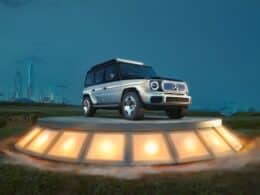Do you remember? In the 90s, the so-called "travel calculator" was still available at Mercedes-Top model over a thousand marks surcharge. At a time when many BMW models had long been equipped with extensive on-board computers as standard and Renault's electronic travel companion had a voice output. The products created by chief designer Bruno Sacco were not only down-to-earth, but also simple and elegant in the best sense. And they radiated an almost limitless solidity, which they were in their best times.
So Mercedes is said to have been conservative? Younger car fans will hardly be able to believe this, because today the brand is extremely courageous when it comes to design. Also and especially in comparison to the competitors from Bavaria. Chief designer Gordon Wagener relies on numerous design centers around the world to further develop the products. Sindelfingen will then bundle what the creative specialists in Brazil, China, India, Japan and the United States will do.

Many countries and regions also means many cultures. Car designers are not only inspired by nature - which is then reflected in trends such as organic design - but also by people, their everyday life, clothing and art. Good design urgently needs international suggestions. Whether it's expensive Italian Riva boats, Japanese shark fins or Brazilian flowers: there are many examples of how lines and elements on and in the car are borrowed from everyday life - be they keys, buttons, light units or, at first glance, banal seeming functional elements such as ventilation nozzles.
Incidentally, it is not that easy to do justice to the widest possible multinational audience. After all, the up-and-coming S-Class customer in China is perhaps only in his early thirties, while upper-class drivers in Europe are rarely under fifty - both have completely different requirements in areas such as entertainment or comfort.

The interior design of modern luxury cars is now also extremely complex, because nowadays craftsmanship and sophisticated infotainment merge with each other, which brings new challenges. Both fields are subject to trends, which is why the creative department has to employ specialists such as fashion and textile designers to keep up with the times for furniture and surfaces. These in turn have to deal with the technical circumstances, which requires cooperation with the relevant experts and interfaces that previously did not exist at all.
What mechanical displays and manageable LCD displays were able to fix just a few years ago is now taken over by a mostly huge monitor area. And there is huge potential for the future here. How will interiors change, especially in view of the increasing autonomization? In particular, the driver will perceive the automotive environment differently in the future because he will concentrate less on driving and more on the other functionalities of the car. The employees of the five Mercedes “Advanced Design Studios” are concerned with such future models. Various studies show what customers might expect in ten or twenty years. In this way, complete fittings become display areas, or projections into the windshield complement the flow of information and go far beyond the performance of today's head-up displays.

Parts of the so-called design process are not digital at all - at least not completely. Drafts are created with the computer, but modeling clay models is still unavoidable in the end. There are real artists at work who can handle the material so virtuously that in the end, scrapers and spatulas create a precise 1: 1 model of what the designers created on the computer - with every little detail , Then the experts look at the result under different, simulated lighting conditions and improve if necessary. After all, reflections play an important role in the effect of shape and color.

This raises the question of what the future of Mercedes design looks like. Exciting studies like F015 or Vision Mercedes-Maybach 6 should always give a foretaste of what future series models might look like. With the sculpture Aesthetics A, manufacturers are giving a preview of the new Mercedes design generation, which could begin with the successor to the A-Class. It should be a surface-related and puristic design - the time of the beads is over, proclaims chief designer Wagener. This "smooth" and "clear" style is already evident in the now starting E-Class Coupé. But the brand fan has to wait a year or two for the end result. (Patrick Broich / SP-X)





